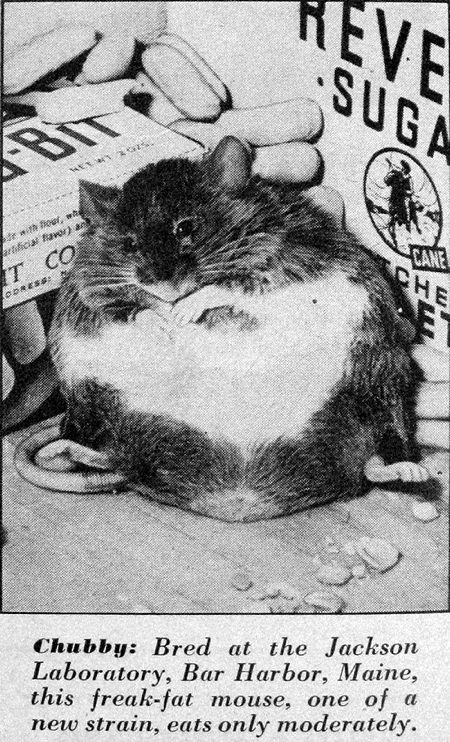Obese, the Freak Fat Mouse
A fat mouse that was bred at Jackson Laboratory in Bar Harbor, Maine during the late 1940s/early 1950s. The researchers called him "Obese," or "O.B." for short. As in, that was his name, not just a description of what he was. Fat mice bred from Obese were used in the study of diabetes and obesity.

Ellen Ruppel Shell tells the story of Obese in her book The Hungry Gene: The Inside Story of the Obesity Industry:

Newsweek - Apr 2, 1951
Ellen Ruppel Shell tells the story of Obese in her book The Hungry Gene: The Inside Story of the Obesity Industry:
In 1947, a wildfire swept through Mount Desert Island and the laboratory, incinerating all but a scattering of the mice. Little was determined to rebuild, and donations of mice — all of them originally bred at Jackson — poured back to the lab from around the United States, Canada, and Great Britain. Among these was a new mutant, the dystrophic mouse that Coleman would use as his model for the study of muscular dystrophy. And two years later, another mutant suddenly appeared in the lab — a mouse with traits that would, some twenty years later, attract and hold Coleman's attention for the rest of his career.
An animal caretaker first spotted the creature huddled in a corner of its cage, grooming itself. It was furrier than most, but what really stood out was the size of the thing — it was hugely fat. The caretaker alerted doctoral candidate Margaret Dickie, who diagnosed the mouse as "pregnant." But there were problems with this theory. For one thing, the mouse never delivered a baby. And on closer inspection, it turned out to be male. The fat mouse ate three times the chow eaten by a normal mouse, pawing for hours at the bar of the food dispenser like an embittered gambler banging away at a recalcitrant slot machine. Between feedings it sat inert. It seemed to have been placed on this earth for no other purpose than to grow fat.
There had been other fat mice. The agouti mouse, named for its mottled yellow fur similar to that of the burrowing South American rodent, is, in its "lethal yellow" mutation, double the weight of the ordinary variety. But the fat agouti was svelte compared to the newcomer. This mouse was outlandish, a joke, a blob of fur splayed out on four dainty paws like a blimp on tricycle wheels. Rather than dart around the cage in mousy abandon, it was docile, phlegmatic, as though resigned to some unspeakable fate. Dickie and her colleagues christened the mouse "obese," later abbreviated to "ob," and pronounced "O.B.," each letter drawn out in its own languid syllable.
An animal caretaker first spotted the creature huddled in a corner of its cage, grooming itself. It was furrier than most, but what really stood out was the size of the thing — it was hugely fat. The caretaker alerted doctoral candidate Margaret Dickie, who diagnosed the mouse as "pregnant." But there were problems with this theory. For one thing, the mouse never delivered a baby. And on closer inspection, it turned out to be male. The fat mouse ate three times the chow eaten by a normal mouse, pawing for hours at the bar of the food dispenser like an embittered gambler banging away at a recalcitrant slot machine. Between feedings it sat inert. It seemed to have been placed on this earth for no other purpose than to grow fat.
There had been other fat mice. The agouti mouse, named for its mottled yellow fur similar to that of the burrowing South American rodent, is, in its "lethal yellow" mutation, double the weight of the ordinary variety. But the fat agouti was svelte compared to the newcomer. This mouse was outlandish, a joke, a blob of fur splayed out on four dainty paws like a blimp on tricycle wheels. Rather than dart around the cage in mousy abandon, it was docile, phlegmatic, as though resigned to some unspeakable fate. Dickie and her colleagues christened the mouse "obese," later abbreviated to "ob," and pronounced "O.B.," each letter drawn out in its own languid syllable.
Comments
I"M NOT FAT!!! I'm just easy to see.
Posted by KDP on 05/08/17 at 04:07 PM
Commenting is not available in this channel entry.

Category: Animals | Science | 1940s | 1950s